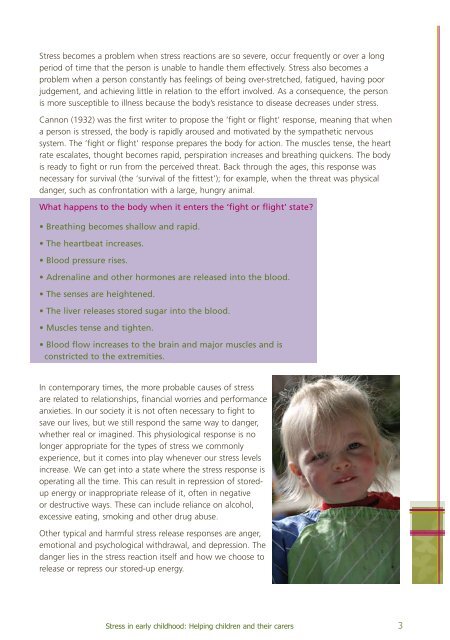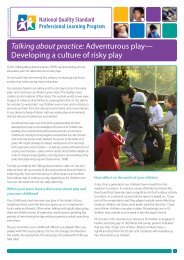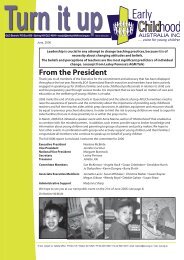Stress in early childhood: Helping children and their carers
Stress in early childhood: Helping children and their carers
Stress in early childhood: Helping children and their carers
You also want an ePaper? Increase the reach of your titles
YUMPU automatically turns print PDFs into web optimized ePapers that Google loves.
<strong>Stress</strong> becomes a problem when stress reactions are so severe, occur frequently or over a long<br />
period of time that the person is unable to h<strong>and</strong>le them effectively. <strong>Stress</strong> also becomes a<br />
problem when a person constantly has feel<strong>in</strong>gs of be<strong>in</strong>g over-stretched, fatigued, hav<strong>in</strong>g poor<br />
judgement, <strong>and</strong> achiev<strong>in</strong>g little <strong>in</strong> relation to the effort <strong>in</strong>volved. As a consequence, the person<br />
is more susceptible to illness because the body’s resistance to disease decreases under stress.<br />
Cannon (1932) was the first writer to propose the ’fight or flight‘ response, mean<strong>in</strong>g that when<br />
a person is stressed, the body is rapidly aroused <strong>and</strong> motivated by the sympathetic nervous<br />
system. The ’fight or flight’ response prepares the body for action. The muscles tense, the heart<br />
rate escalates, thought becomes rapid, perspiration <strong>in</strong>creases <strong>and</strong> breath<strong>in</strong>g quickens. The body<br />
is ready to fight or run from the perceived threat. Back through the ages, this response was<br />
necessary for survival (the ‘survival of the fittest’); for example, when the threat was physical<br />
danger, such as confrontation with a large, hungry animal.<br />
What happens to the body when it enters the ‘fight or flight’ state?<br />
• Breath<strong>in</strong>g becomes shallow <strong>and</strong> rapid.<br />
• The heartbeat <strong>in</strong>creases.<br />
• Blood pressure rises.<br />
• Adrenal<strong>in</strong>e <strong>and</strong> other hormones are released <strong>in</strong>to the blood.<br />
• The senses are heightened.<br />
• The liver releases stored sugar <strong>in</strong>to the blood.<br />
• Muscles tense <strong>and</strong> tighten.<br />
• Blood flow <strong>in</strong>creases to the bra<strong>in</strong> <strong>and</strong> major muscles <strong>and</strong> is<br />
constricted to the extremities.<br />
In contemporary times, the more probable causes of stress<br />
are related to relationships, f<strong>in</strong>ancial worries <strong>and</strong> performance<br />
anxieties. In our society it is not often necessary to fight to<br />
save our lives, but we still respond the same way to danger,<br />
whether real or imag<strong>in</strong>ed. This physiological response is no<br />
longer appropriate for the types of stress we commonly<br />
experience, but it comes <strong>in</strong>to play whenever our stress levels<br />
<strong>in</strong>crease. We can get <strong>in</strong>to a state where the stress response is<br />
operat<strong>in</strong>g all the time. This can result <strong>in</strong> repression of storedup<br />
energy or <strong>in</strong>appropriate release of it, often <strong>in</strong> negative<br />
or destructive ways. These can <strong>in</strong>clude reliance on alcohol,<br />
excessive eat<strong>in</strong>g, smok<strong>in</strong>g <strong>and</strong> other drug abuse.<br />
Other typical <strong>and</strong> harmful stress release responses are anger,<br />
emotional <strong>and</strong> psychological withdrawal, <strong>and</strong> depression. The<br />
danger lies <strong>in</strong> the stress reaction itself <strong>and</strong> how we choose to<br />
release or repress our stored-up energy.<br />
<strong>Stress</strong> <strong>in</strong> <strong>early</strong> <strong>childhood</strong>: Help<strong>in</strong>g <strong>children</strong> <strong>and</strong> <strong>their</strong> <strong>carers</strong> 3











